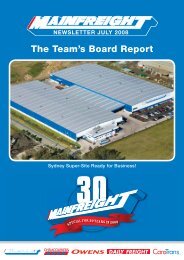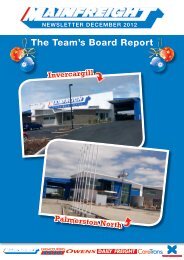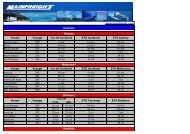Annual Report 2013 - Mainfreight
Annual Report 2013 - Mainfreight
Annual Report 2013 - Mainfreight
You also want an ePaper? Increase the reach of your titles
YUMPU automatically turns print PDFs into web optimized ePapers that Google loves.
2 Summary of Significant Accounting Policies (continued)<br />
(d) Business Combinations<br />
The acquisition method of accounting is used to account for all business combinations regardless of whether equity instruments or<br />
other assets are acquired. Cost is measured as the fair value of the assets given, shares issued or liabilities incurred or assumed at the<br />
date of exchange. Where equity instruments are issued in a business combination, the fair value of the instruments is their published<br />
market price as at the date of exchange unless, in rare circumstances, it can be demonstrated that the published price at the date of<br />
exchange is an unreliable indicator of fair value and that other evidence and valuation methods provide a more reliable measure of fair<br />
value. Transaction costs arising on the issue of equity instruments are recognised directly in equity.<br />
Except for non-current assets or disposal groups classified as held for sale (which are measured at fair value less costs to sell), all<br />
identifiable assets acquired and liabilities and contingent liabilities assumed in a business combination are measured initially at their<br />
fair values at the acquisition date, irrespective of the extent of any minority interest. The excess of the cost of the business combination<br />
over the net fair value of the Group’s share of the identifiable net assets acquired is recognised as goodwill. If the cost of acquisition is<br />
less than the Group’s share of the net fair value of the identifiable net assets of the subsidiary, the difference is recognised as a gain in<br />
the income statement, but only after a reassessment of the identification and measurement of the net assets acquired.<br />
Where settlement of any part of the consideration is deferred, the amounts payable in the future are discounted to their present value<br />
as at the date of exchange. The discount rate used is the entity’s incremental borrowing rate, being the rate at which a similar borrowing<br />
could be obtained from an independent financier under comparable terms and conditions.<br />
(e) Segment <strong>Report</strong>ing<br />
An operating segment is a component of an entity that engages in business activities from which it may earn revenues and incur<br />
expenses whose operating results are regularly reviewed by the entity’s chief operating decision maker and for which discrete financial<br />
information is available.<br />
(f) Foreign Currency Translation<br />
(i) Functional and Presentation Currency<br />
Both the functional and presentation currency of <strong>Mainfreight</strong> Limited and its New Zealand subsidiaries is New Zealand dollars<br />
($). Each entity in the Group determines its own functional currency and items included in the financial statements of each entity<br />
are measured using that functional currency.<br />
(ii) Transactions and Balances<br />
Transactions in foreign currencies are initially recorded in the functional currency by applying the exchange rates ruling at the<br />
date of the transaction. Monetary assets and liabilities denominated in foreign currencies are retranslated at the rate of exchange<br />
ruling at the balance sheet date.<br />
All exchange differences in the consolidated financial statements are taken to profit or loss with the exception of differences on<br />
foreign currency borrowings that provide a hedge against a net investment and differences arising on translation of a foreign<br />
operation. These are recognised in other comprehensive income and accumulated in reserves until disposal of the net investment<br />
at which time they are recognised in profit or loss. On disposal of a foreign operation, the cumulative amount recognised in<br />
equity relating to that particular foreign operation is recognised in profit or loss. Tax charges and credits attributable to exchange<br />
differences on those borrowings are also recognised in equity.<br />
Non-monetary items that are measured in terms of historical cost in a foreign currency are translated using the exchange rate<br />
as at the date of the initial transaction. Non-monetary items measured at fair value in a foreign currency are translated using the<br />
exchange rates at the date when the fair value was determined (refer to g (iii)).<br />
72 <strong>Mainfreight</strong> | <strong>Annual</strong> <strong>Report</strong> <strong>2013</strong>
















